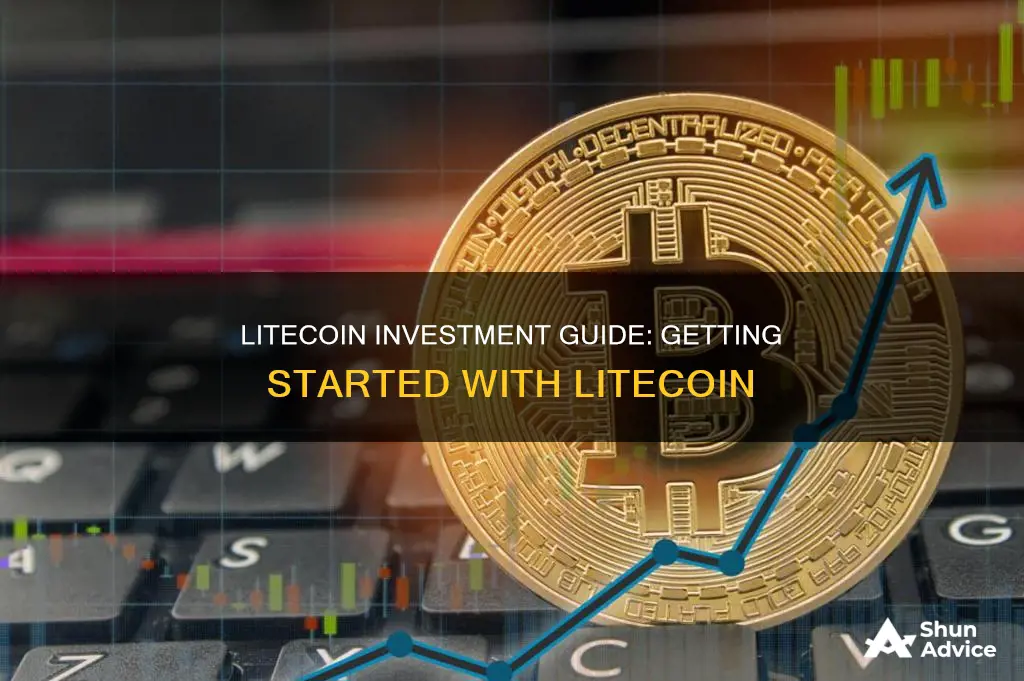
Litecoin is one of the oldest cryptocurrencies in the market, often referred to as the silver to Bitcoin's gold. It was created by Charlie Lee, a former Google employee, and launched in 2011. Litecoin is a blockchain-based cryptocurrency that can be used to send money anywhere in a secure and mostly anonymous way. It is faster and easier to mine than Bitcoin, with a transaction confirmation time of 2.5 minutes, as opposed to Bitcoin's 10 minutes. It also has lower transaction fees. However, it is less secure than Bitcoin. Litecoin is available for purchase on several exchanges, including Kraken, Bitstamp, Uphold, and Binance.
| Characteristics | Values |
|---|---|
| Cryptocurrency | Litecoin (LTC) |
| Cryptocurrency Type | Altcoin |
| Cryptocurrency Similarity | Bitcoin |
| Cryptocurrency Ranking | #18 on Coinmarketcap |
| Market Capitalization | $5 billion |
| Ticker Symbol | LTC |
| Transaction Speed | 2.5 minutes |
| Transaction Fees | Lower than Bitcoin |
| Supply | 84 million LTC |
| Founder | Charlie Lee |
| Year of Launch | 2011 |
| Investment Platforms | Coinbase, eToro, Interactive Brokers, Gemini, Kraken, Bitstamp, Uphold, Binance, KuCoin, WazirX |
What You'll Learn

How to buy Litecoin
Litecoin is one of the oldest cryptocurrencies and is often referred to as the "silver to Bitcoin's gold". It is a good investment option for those who want to try their luck in the crypto market without the rollercoaster ride of Bitcoin investment.
Step 1: Sign Up for an Exchange
To buy Litecoin, you need to sign up for a cryptocurrency exchange such as Coinbase, Kraken, Bitstamp, Uphold, Binance, KuCoin, WazirX, or eToro. These exchanges allow you to buy, sell, and trade cryptocurrencies.
Step 2: Verify Your Information
Most exchanges will require you to verify your identity before you can start trading. This usually involves providing personal information such as your full name, email address, phone number, and proof of residence. Some exchanges may also require a photo ID.
Step 3: Add a Payment Method
To purchase Litecoin, you need to add a payment method to your account. This could be a bank account, credit card, or debit card. Make sure to check the fees associated with each payment method, as they may vary.
Step 4: Place a Buy Order
Once your account is set up and funded, you can place a buy order for Litecoin. There are different types of buy orders, such as market orders and limit orders. A market order will purchase Litecoin at the current market rate, while a limit order allows you to set a maximum price you're willing to pay.
Step 5: Store Your Litecoin in a Wallet
After purchasing Litecoin, consider transferring it to a crypto wallet for added security. There are two main types of crypto wallets: hardware wallets and software wallets. Hardware wallets, such as the Ledger Nano X, are "cold" wallets that keep your crypto offline and are considered more secure. Software wallets, such as ZenGo, are internet-enabled and more convenient for storing smaller amounts for spending.
Step 6: Monitor the Market
Investing in cryptocurrencies involves risk, so it's important to monitor the market and stay up-to-date with news and developments that may impact the value of Litecoin. Keep in mind that the crypto market is highly volatile, and prices can fluctuate significantly.
Step 7: Consider Trading or Holding
You can choose to hold onto your Litecoin in anticipation of long-term price appreciation, or you can actively trade it on the exchanges to try and profit from short-term price movements. Remember that trading carries higher risks and requires a good understanding of the market.
Gold Coins: Smart Investment or Risky Business?
You may want to see also

Best wallets for Litecoin
When it comes to Litecoin wallets, there are a few options to choose from, depending on your needs and preferences. Here are some of the best wallets for Litecoin:
Litewallet (formerly Loafwallet)
Litewallet is an app-based wallet developed by the Litecoin Foundation, the non-profit organisation that supports Litecoin. It is available for both iOS and Android devices and is free to download, making it a straightforward option for storing Litecoin. The wallet uses recovery or "seed" phrases as a backup, and it supports SegWit, ensuring a clean interface. However, it now charges a fee to send LTC, which is separate from the standard transaction fee.
Litecoin Core
Litecoin Core is open-source software that runs a copy of the entire Litecoin blockchain on your computer, contributing to the protection of the Litecoin network. It can be installed on Windows, Linux, or macOS computers. However, it requires a lot of hard drive space (at least 25GB) and is not compatible with other cryptocurrencies. Additionally, it lacks two-factor authentication, which may be a security concern for some users.
Trust Wallet
Trust Wallet is a hot storage method that supports more than 4.5 million digital assets, including Litecoin. It enables purchases, exchanges, and staking directly from the wallet. Trust Wallet is fully open-source and integrates smoothly with Binance and Binance.US, facilitating smooth asset transfers and trading. However, it cannot directly convert to cold storage, and the company doesn't offer a browser extension.
Exodus
Exodus is another hot wallet that supports a wide range of cryptocurrencies, including Litecoin. It offers a mobile app, a desktop app, and a browser extension. Exodus allows users to buy, trade, and stake directly from its platform. Additionally, it provides an integrated exchange, email support, and live chat. Exodus also integrates with the Trezor cold wallet, making it easy for users to move their crypto between hot and cold storage.
Trezor
Trezor is a hardware wallet that stores over 1,000 different cryptocurrencies, including Litecoin. It connects to a phone or computer via USB-C and offers backup security protection through desktop or mobile apps. The standard version costs around $72, while the advanced touchscreen version costs $255. Trezor provides built-in services such as staking and crypto purchases and has a dedicated Litecoin wiki page for users.
Ledger
Ledger is a well-known hardware wallet in the shape of a flash drive. It can store over 5,500 cryptocurrencies, including Litecoin, and connect to software wallets like Crypto.com DeFi Wallet and Guarda. Ledger offers both mobile and desktop applications and has a dedicated Litecoin support page on its website. The Nano S Plus model is the most economical option, priced at $79.
El Salvador's Bitcoin Gamble: Millions Invested
You may want to see also

Litecoin vs. Bitcoin
Litecoin is often described as the "silver to Bitcoin's gold". It is one of the oldest cryptocurrencies and has maintained its relevance in the crypto community over the years.
Litecoin was created in 2011 by Charlie Lee, a former Google employee, as an "off-brand Bitcoin of sorts". It is based on the Bitcoin implementation, but with improvements to increase its viability as a general-use cryptocurrency.
- Transaction Speed: Litecoin can confirm transactions in 2.5 minutes, four times faster than Bitcoin's average of 9 to 10 minutes. This is due to Litecoin's use of the Scrypt Algorithm, which is faster and less energy-intensive than Bitcoin's SHA-256 algorithm.
- Transaction Fees: Litecoin transactions are much cheaper than Bitcoin transactions due to the lower amount of work required to authenticate a block.
- Scalability: Litecoin's faster transaction speeds also improve its scalability compared to Bitcoin.
- Coin Cap: Litecoin has a higher coin cap of 84 million LTC, compared to Bitcoin's cap of 21 million BTC. This results in a lower price per token for Litecoin.
- Hashing Function: Litecoin uses Scrypt for its hashing function, while Bitcoin uses SHA-256, which is processed very quickly on graphics processing units and specialized machines.
- Market Capitalization: Bitcoin has a much higher market capitalization due to its greater demand and smaller supply.
In summary, Litecoin was designed to address some of the limitations of Bitcoin, particularly in terms of transaction speed, fees, and scalability. However, Bitcoin remains the more popular and valuable cryptocurrency due to its higher demand and smaller supply.
Creating a Fake Bitcoin Investment Website: A Step-by-Step Guide
You may want to see also

Litecoin vs. Dogecoin
Litecoin and Dogecoin are two of the oldest and most popular cryptocurrencies. Both are based on the proof-of-work concept and were created as alternatives to Bitcoin. However, there are some key differences between the two.
Litecoin was launched in 2011 as a faster and cheaper alternative to Bitcoin. It is often described as the "silver to Bitcoin's gold". Litecoin has a fixed maximum supply of 84 million coins, and transactions on its network are faster than Bitcoin, taking around 2.5 minutes to confirm. Litecoin also has lower transaction fees compared to other cryptocurrencies, making it a popular choice for investors looking for short or mid-term trading.
Dogecoin, on the other hand, was introduced in 2013 as a joke or satire about cryptocurrencies. It quickly gained a large community of supporters, including public figures such as Elon Musk and Mark Cuban. Dogecoin has an unlimited supply of coins, and its transactions are processed faster than Litecoin, taking around 1 minute to generate a block. Dogecoin is also known for its volatile nature, with wild price swings and erratic trends.
When it comes to investing, both cryptocurrencies have their advantages. Litecoin might be a better long-term investment due to its capped supply, which removes inflation risk. On the other hand, Dogecoin's unlimited supply and volatile nature can lead to more significant price increases over shorter periods. Additionally, Dogecoin has a more accessible mining process and is actively involved in charitable projects.
In terms of market capitalization, Litecoin currently stands at 16th, while Dogecoin is the 10th biggest cryptocurrency in the world. However, this is not the only factor to consider when deciding whether to invest in Dogecoin or Litecoin. It is crucial to look at the strength of the project, the community, the founders, short-term volatility, and other factors.
Smart Coin Investment Strategies for Beginners
You may want to see also

How to mine Litecoin
Mining Litecoin involves validating transactions in the Litecoin blockchain, closing the block, opening a new one, and receiving a reward. Litecoin uses a proof-of-work consensus mechanism, similar to Bitcoin, to validate transactions and secure the network. Miners use specialised hardware and software to solve complex mathematical problems, known as hashes, to create new blocks.
Step 1: Understand the Hardware Requirements
To mine Litecoin, you will need specialised hardware called ASIC miners (Application-Specific Integrated Circuits) or powerful GPUs (Graphics Processing Units). These devices are designed to perform the complex calculations required for mining more efficiently than traditional CPUs.
Step 2: Set Up Your Litecoin Wallet
Before mining, you will need a wallet to store your Litecoin. Various crypto wallets are available, including hardware, software, and online wallets. Choose a reputable wallet that offers high security and supports Litecoin.
Step 3: Choose Mining Software
Select mining software that is compatible with your hardware and operating system. Popular mining software for Litecoin includes CGMiner, EasyMiner, and BFGMiner.
Step 4: Join a Mining Pool (Optional)
While it is possible to mine Litecoin individually, joining a mining pool can increase your chances of earning consistent rewards. In a mining pool, multiple miners combine their computing power to solve hashes collectively. Rewards are distributed among pool members based on their contribution.
Step 5: Configure Your Mining Software
Configure your mining software with the necessary information, including the pool's address, your wallet address, and parameters specific to your hardware and software. Refer to the instructions provided by the mining software or pool for detailed setup guidelines.
Step 6: Start Mining Litecoin
After the setup, launch your mining software and monitor its performance. Keep your hardware cool and ensure a stable internet connection for uninterrupted mining.
Step 7: Monitor and Optimize Your Mining Operation
Regularly monitor your mining operation to ensure profitability. Keep an eye on electricity costs, hardware performance, and market conditions. Adjust your mining settings and strategies to maximise earnings. Stay informed about the latest developments in Litecoin mining to stay ahead of the competition.
Factors Affecting Mining Profitability:
- Hash Rate: A higher hash rate increases your chances of mining a block and earning rewards.
- Electricity Costs: Mining consumes significant electricity, impacting profitability. Choose energy-efficient hardware to minimise costs.
- Mining Difficulty: The mining difficulty adjusts regularly to maintain a consistent block time. Higher difficulty reduces rewards earned per hash.
- Market Conditions: The price of Litecoin in the market directly affects mining profitability.
Tips:
- Hardware Selection: Consider factors such as hash rate, power consumption, cost, reliability, and longevity when choosing mining hardware.
- Mining Software: Research and select user-friendly software that suits your needs and is compatible with your hardware and operating system.
- Mining Pools: Joining a mining pool increases your chances of consistent rewards, especially with limited resources. However, some miners prefer solo mining for the potential to earn the entire block reward.
- Optimisation: To optimise your mining operation, consider hardware efficiency, electricity costs, mining pool selection, and market conditions. Regularly adjust your mining settings for optimal profitability.
- Wallet Selection: Choose a reputable wallet that offers high security and supports Litecoin to store your mining earnings.
Mining Litecoin offers advantages such as profitability, supporting the decentralisation of the Litecoin network, and providing a hands-on learning experience about blockchain technology and cryptocurrencies.
Reef Coin Investment: Worthwhile or Risky Venture?
You may want to see also
Frequently asked questions
You can invest in Litecoin by purchasing it on a crypto exchange and storing it in a digital wallet.
Litecoin has faster transaction speeds and lower transaction costs than Bitcoin. It also has an active developer working on it, and it is widely adopted and traded on virtually all crypto exchanges.
Litecoin's infrastructure is aging, and there are competing altcoins that offer similar benefits. There is also less security compared to Bitcoin, and shaky faith in leadership since its founder, Charles Lee, sold all of his stake in 2017.







